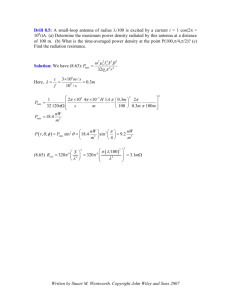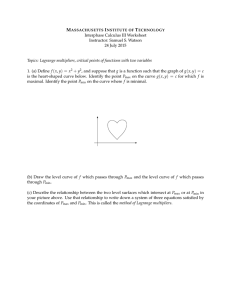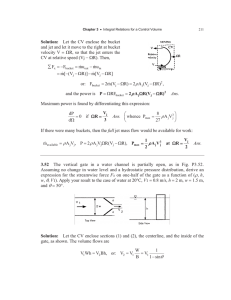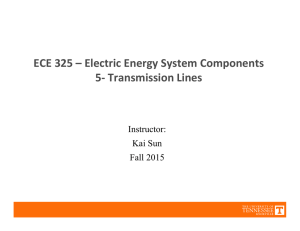1 Greedy Load Balancing Algorithm
advertisement
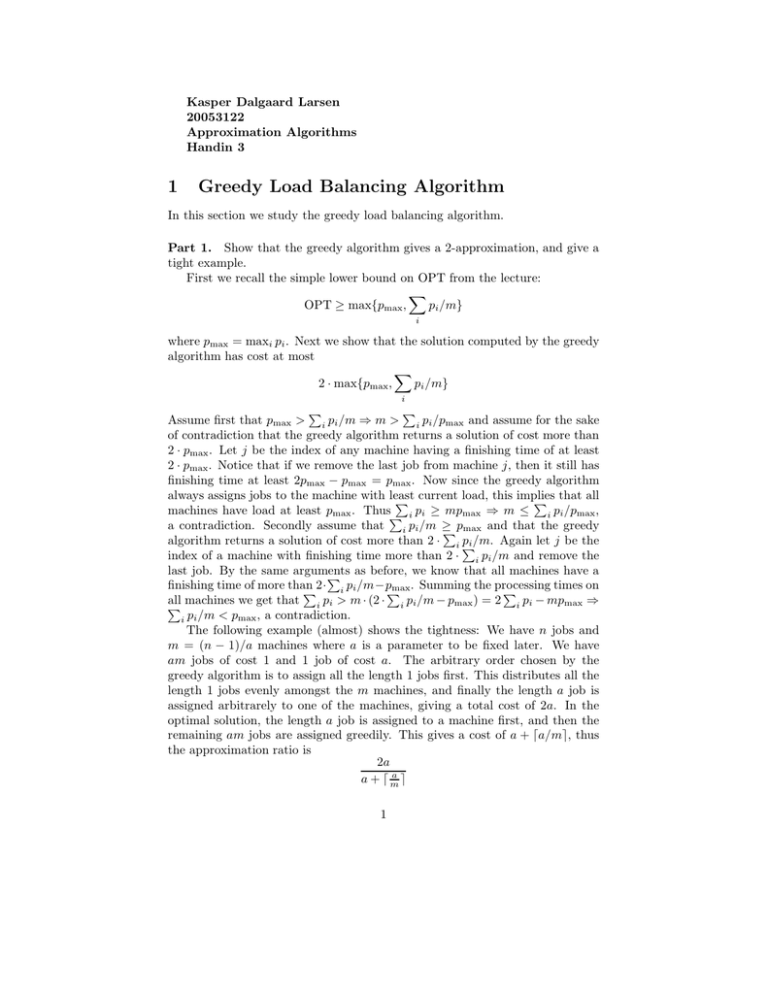
Kasper Dalgaard Larsen
20053122
Approximation Algorithms
Handin 3
1
Greedy Load Balancing Algorithm
In this section we study the greedy load balancing algorithm.
Part 1. Show that the greedy algorithm gives a 2-approximation, and give a
tight example.
First we recall the simple lower bound on OPT from the lecture:
X
pi /m}
OPT ≥ max{pmax ,
i
where pmax = maxi pi . Next we show that the solution computed by the greedy
algorithm has cost at most
X
pi /m}
2 · max{pmax ,
i
P
Assume first that pmax > i pi /m ⇒ m > i pi /pmax and assume for the sake
of contradiction that the greedy algorithm returns a solution of cost more than
2 · pmax . Let j be the index of any machine having a finishing time of at least
2 · pmax . Notice that if we remove the last job from machine j, then it still has
finishing time at least 2pmax − pmax = pmax . Now since the greedy algorithm
always assigns jobs to the machine with least
P that all
P current load, this implies
machines have load at least pmax . ThusP i pi ≥ mpmax ⇒ m ≤ i pi /pmax ,
a contradiction. Secondly assume that i pi /m ≥
P pmax and that the greedy
pi /m. Again let j be the
algorithm returns a solution of cost more than 2 · i P
index of a machine with finishing time more than 2 · i pi /m and remove the
last job. By the same arguments
P as before, we know that all machines have a
times on
finishing time of more than
2·
max . Summing the processing
i pi /m−p
P
P
P
p
−
mp
p
/m
−
p
)
=
2
p
>
m
·
(2
·
all
machines
we
get
that
i
max ⇒
i
max
i
i
i
i
P
p
/m
<
p
,
a
contradiction.
i
max
i
The following example (almost) shows the tightness: We have n jobs and
m = (n − 1)/a machines where a is a parameter to be fixed later. We have
am jobs of cost 1 and 1 job of cost a. The arbitrary order chosen by the
greedy algorithm is to assign all the length 1 jobs first. This distributes all the
length 1 jobs evenly amongst the m machines, and finally the length a job is
assigned arbitrarely to one of the machines, giving a total cost of 2a. In the
optimal solution, the length a job is assigned to a machine first, and then the
remaining am jobs are assigned greedily. This gives a cost of a + ⌈a/m⌉, thus
the approximation ratio is
2a
a
⌉
a + ⌈m
P
1
Choosing a =
becomes
√
√
n − 1 we have m = a = n − 1, and the approximation ratio
2a
2m
=
=
a+1
m+1
1
2
2
2− m
2
1
=
1
1 ≥ 2− m
+ 2m
1 − m2
Part 2. Show that if jobs are ordered in decreasing length, then the approximation ratio is 23 .
Again, we use the lower bounds from above, giving
X
pi /m}
OPT ≥ max{pmax ,
i
We will assume that p1 ≥ p2 ≥ · · · ≥ pn , implying that jobs get assigned
in this
P
order by the modified greedy algorithm. Assume first that pmax > i pi /m and
that the modified greedy algorithm gives a solution of cost more than 32 pmax .
Let j be the index of a machine with maximum load and consider the last job
assigned to it. This job has length pk for some k. Removing this job, we know
that after assigning the jobs of length p1 . . . pk−1 , all machines have load more
than 23 pmax − pk . Since this is greater than pmax , we must have at least 2 jobs
on every machine, thus m ≤ k−1
2 . Summing all weights, we get that
X
pi >
i
n
X
i=k
3
pi + m · ( pmax − pk ) ⇒
2
k−1
X
3X
pi + mpk ⇒
pi <
2 i
i=1
k−1
n
1X
3X
(k − 1)
pi +
pk ⇒
pi < mpk ≤
2 i=1
2
2
i=k
n
3X
k−1
k−1
pk +
pk ⇒
pi <
2
2
2
i=k
n
3X
pi < 0
2
i=k
P
which is a contradiction since all weights are positive. Secondly, assume i pi /m ≥
pmax
and that the modified greedy algorithm gives a solution of cost more than
3 P
i pi /m. Let j and k be as before and remove job k from machine j. The
2
load onP
all machines after assigning the jobs of length p1 , . . . , pk−1 is then more
than 23 i pi /m − pk ≥ 23 pmax − pk . Thus m ≤ k−1
2 and
k−1
X
i=1
pi > m · (
3X
3X
pi /m − pk ) =
pi − mpk
2 i
2 i
We can now repeat the calculations from above and get our contradiction.
2
2
Question 2
First check if there are any jobs of length > T , in which case we return No.
Otherwise, define variables M (x1 , . . . , xk ) as in
Pthe hint. Notice that since ai <
T for all i, we have M (x1 , . . . , xk ) = 1 when
xi = 1 and M (0, 0, . . . , 0) = 0.
We now compute the M variables in iterations, such thatP
in the j’th iteration,
we compute the answer for all combinations of xi where
xi = j. To fill out
entry M (x1 , . . . , xk ) in the j’th iteration, we “fix” the jobs on the last P
machine.
This is done by trying all combinations of values (y1 , . . . , yk ) such that yi > 0
and yi ≤ xi for all i. Intuitively, this corresponds to deciding how many jobs
yP
i of length ai to place on the last machine. For each such combination, if
yi · ai < T , we let
M (x1 , . . . , xk ) := min{M (x1 − y1 , . . . , xk − yk ) + 1, M (x1 , . . . , xk )}.
where M (x1 , . . . , xk ) = ∞ if it has not yet been assigned a value. Once we
reach the n’th iteration, we can read off how many machines are needed to
schedule the jobs given as input. If this is greater than the number of available
machines, return No, and otherwise return Yes. To also obtain a valid schedule,
one could store the jobs assigned to the last machine whenever overwriting the
M (x1 , . . . , xk ) variables. Backtracking through the variables would give a valid
schedule.
Analysis. First notice that there are j+k−1
ways of choosing k integers
k−1
summing to j. Thus we have the following bound on the running time
j n X
j+k−1 X i+k−1
j=2
k−1
i=1
k−1
=
j n X
X
j+k−1 i+k−1
j=2 i=1
k−1
k−1
where the inner binomial coefficient originates from choosing the yi ’s and the
outer from choosing the xi ’s. This sum is bounded by
2k−2
2k−2
2
en
n+k−1
(n + k − 1)e
2
2
=n
+e
n
≤n
k−1
k−1
k−1
2
which for k ≥ 4 and n ≥ e/(1 − e/3) is bounded by
n2 n2k−2 = n2k
3
